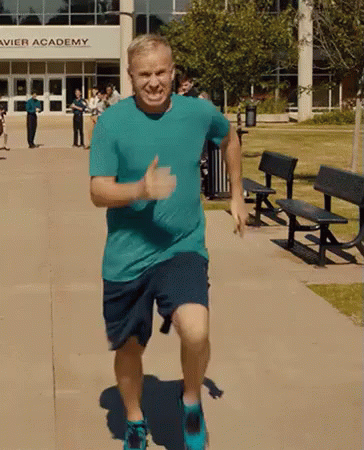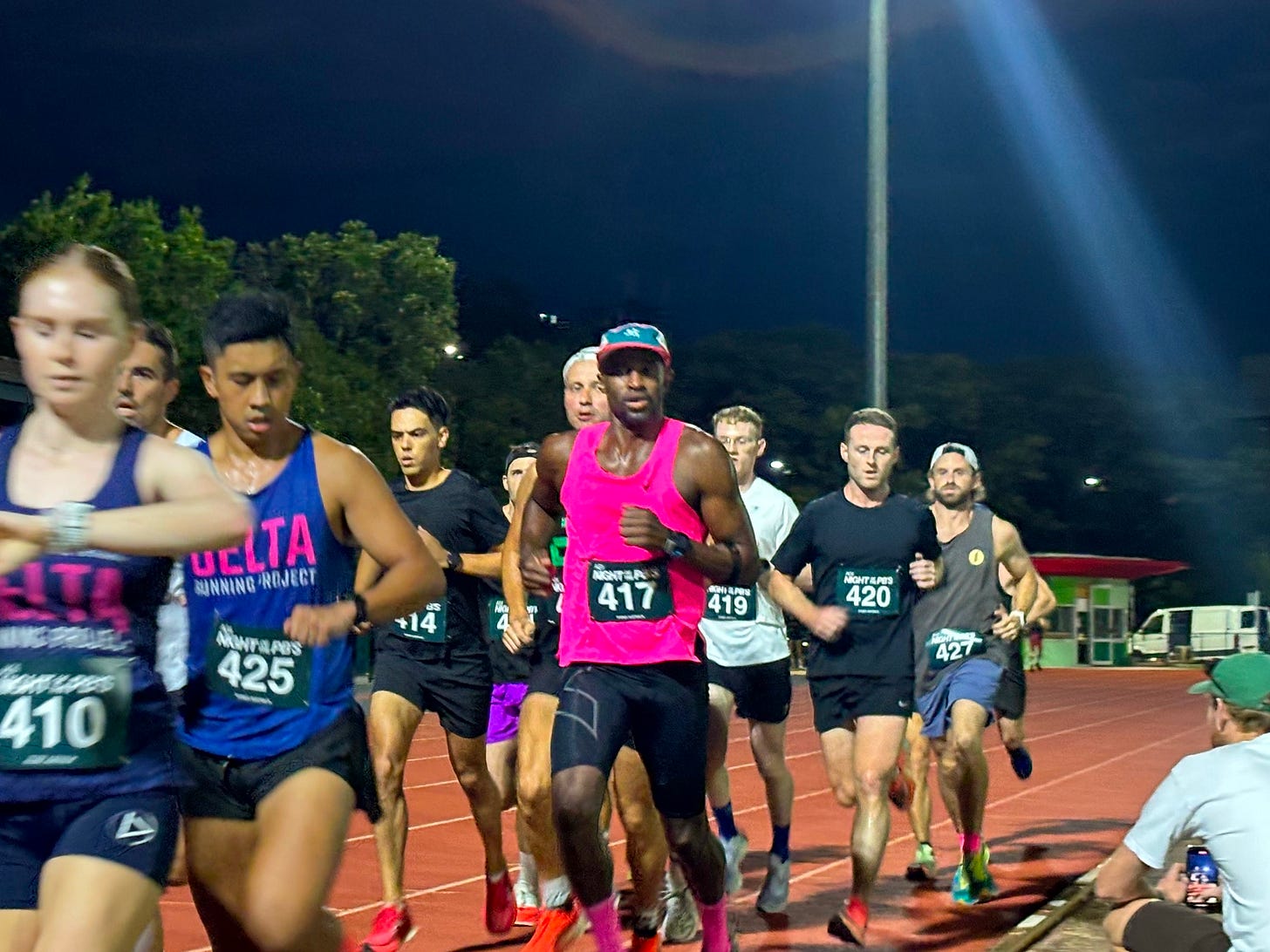Sub-3 Marathon Training Updates: I’m not stupid Daren anymore
Rosario 800m Workout + It's not about the journey/destination
Here’s the Deal
🗒️ Sub-3-Hour Marathon Training Updates — I’m not stupid, Daren anymore
🏃♂️ How This Guy Took A 9-Year Break And Ran 11% Faster Marathon | Adam Jaffrey
📠 Do This Workout Two Weeks Before Your Marathon (or race) To See If You’re Goal Times Are Alternative Facts
🗒️ Sub-3-Hour Marathon Training Updates — I’m not stupid, Daren anymore
Fun story about wisdom and experience.
It started like any other Wednesday morning—except I was eight weeks out from the marathon. I woke up feeling surprisingly good, especially considering I had just crushed a VO2 max interval session the day before.
I headed out for a chill recovery run around the grass field, and then… something weird happened. Like, really weird. Out of nowhere, I felt a spasm in my hamstring. It was like someone just punched me in the back of the leg. I’d never felt anything like it. It didn’t knock me out of commission, and I could still run, hit tempos, do strides and sprints—everything. But my left hamstring felt tighter than usual, and stayed that way for a few days.
By the third day, it loosened up. All good, right? I had a long run coming up, so I headed out for a relatively easy marathon-paced 33km (about 21 miles). Everything felt smooth—until halfway through. BOOM. Same thing. Hamstring spasm. Again. I managed to finish the run, but the soreness returned for another two days. That’s when I started getting concerned. I figured it was time to actually do something about it—more mobility work, some hamstring-focused strength training. You know, all the things I should’ve probably already been doing.
Four days later… BOOM. It hit again. This time right at the end of one of my favorite track workouts (11x400m with half rest). Same leg. Same story. And I was just like—WTF is going on?
Cue the deep dive: researching, Googling, and CHAT GPTing my way down the rabbit hole. Then, finally, a breadcrumb that helped me start piecing things together.
The next morning, I noticed my lower back was sore. Actually, it had been sore for a while—probably ever since I ramped up my long runs past the 30km (18+ mile) mark. That’s when the lightbulb went off. Tight hips + tight lower back = shortened stride — and that meant my hamstring was getting yanked every time I ran. Not ideal. Turns out, it wasn’t just my hamstring—it was my psoas (that deep muscle in the lower back/upper pelvis) that was super tight and inflamed.
I didn’t want to skip my upcoming 10K time trial and longish run the next day, so I booked a massage immediately. This therapist went hard. Brutal, but worth it—I felt a little better afterward. I followed it up with stretching everything around the psoas two to three times that day, trying to get ahead of it before the next “BOOM.”
The 10k time trial went great, with no strains/spasms, and in general, the run was one of my best runs. I decided to replace all easy runs with cross-training sessions for the next week. I got friendly once again with my pool floating belt and the elliptical machine at the gym. I only ran my “quality” faster sessions on the road and long run. It seems to have done the trick, as everything is less sore and not as tight.
I’m slowly transitioning my cross-training workouts to running, but if I have even the slightest issue, it’s back to cross-training.
I love using this new cross-training tool to help me keep the intensity and volume up while letting my body recover. Old Daren eight years ago would have run through it because, that’s what I do. Let’s see how I go over the biggest run of the training period (33km/22-mile run with 18-20 miles at marathon pace effort).
Marathon training ain’t no joke!
🏃♂️How This Guy Took A 9-Year Break And Ran 11% Faster Marathon | Adam Jaffrey
It’s really not about the journey or the destination — It’s something even better.
I ran and did a video podcast with another video podcast producer (small world). He’s back from retirement and into marathon running again.
Persistence: The Underrated Power Move
Truth bomb: talent is nice, but persistence wins in the long run (pun intended). Everyone raves about “natural ability,” but the folks who just keep showing up—rain or shine—are the ones who actually cross the finish line. Boring? Maybe. Effective? Absolutely. One foot in front of the other, every single day.
Enjoy the Grind (Or You’ll Ditch)
Let’s be honest… nobody loves waking up at 5 AM to run 10 miles in the rain, or staying up late refining a project no one else might notice. The trick is finding the parts you do like—maybe that post-run clarity or the tiny burst of pride when you finally finish a piece of work. You don’t need to love every single second—just enough to keep you from bailing.
Perfection Is a Scam
Perfectionism is basically fear in fancy clothes. It whispers, “Not yet, you’ll ruin it,” and keeps you stuck. Real progress is made in little increments, half-baked attempts, and baby steps that eventually add up. Forget aiming for perfect. Aim for done. Then do it a little better tomorrow.
Finish Line Question
After you finish that race or wrap up that project—or even just survive another chaotic Monday—ask yourself: who am I turning into right now? If you’re not loving that answer, maybe it’s time to lace up, roll up your sleeves, and get right back to it.
Listen & read the rest here or watch above to the full episode to level up your run game.
📠 Do This Workout Two Weeks Before Your Marathon (or race) To See If You’re Goal Times Are Alternative Facts
Rosario 800s are basically Yasso 800s with a bit more bite to mimic the mental fatigue that marathons put you in toward the last 10km (6 miles). Created by elite marathon coach, Ben Rosario, they are modified (and I think better) from Yasso 800s.
Yasso 800s are a series of 800-meter repeats, typically matching the time in minutes and seconds you aim for in hours and minutes for your marathon, used to predict potential marathon finish times and build endurance.
The issues I’ve had (and others, because even Bart Yasso himself said they aren’t the only or best marathon predictor) with Yasso 800s is they only tell you if you can’t hit the marathon time. If you do hit the splits with the Yasso 800 workout it doesn’t mean you can actually hit that marathon time. My theory is that because they are short, people with fast twitch muscles or high Vo2Max can “fake it” and do quite well. I am in that camp — so Rosario 800s keep me honest.
If you’re an experienced marathoner/runner, you can put them into your plan about two to three weeks before your marathon. If this is your first time to the marathon rodeo, I’d suggest doing these 5-6 weeks before your marathon as they are pretty taxing. If it goes well you can do another one three weeks out.
Do this you’ll know if you can really hit your goal pace—plus you’ll snag a final fitness bump before taper time.
What It Is
A tweaked take on Yasso 800s: You’ll still do 800-meter intervals, but the intensity is dialed in to confirm marathon readiness.
Short rest, high payoff: Tight recovery windows keep your heart rate up and your legs on edge.
A race-day reality check: If you can handle these intervals, your goal pace is likely right on point.
Why It’s Important
Measure your pacing guts: Shows whether you can realistically hold your dream speed for 26.2 miles.
Sharpen your knife: It adds a final layer of aerobic strength and mental tenacity before the big day.
Mental game boost: Getting through tough repeats now makes race-day suffering feel more manageable. It will still suck though. 🥹
How to Do It
Figure out your Yasso 800 pace:
If you’re aiming for a 3-hour 30-minute marathon, your “Yasso pace” would be 3 minutes and 30 seconds per 800m. Or use the VDot calculator based on a recent race or training interval session.
In miles, that’s 8:00 per mile pace, or roughly 5:00 per kilometer. This will take you
This time is your benchmark for the faster half of each set.
For the slower part just slow down the pace by 25 seconds (8:25 pmin per mile) or 5:15 min per km.
OKAY! With all of that silly math behind us, let's get into the workout.
Warm up thoroughly:
Jog 10-15 minutes at an easy effort, slightly increasing pace to a moderate effort as you feel more warmed up.
Add dynamic stretches (leg swings, lunges, etc.), plyos and run form drills to prep your muscles.
Run paired 800s:
Fast 800: Hit your target Yasso pace (e.g., 3 minutes and 30 seconds per 800).
‘Float’ 800: Immediately follow with another 800 at roughly 25 seconds slower than your fast split.
For a 3 minute 30 seconds 800m pace, that’s around 4:15 to 4:20 (or about 8:25–8:35 per mile pace / 4:51–5:00 per km).
No standing rest—keep moving forward to mimic sustained race effort.
Pace consistency is key:
Aim for 4-6 total pairs (less for beginners, more for advanced runners) if you’re two to three weeks out from your marathon.
If you want to really mimic the race, do one last 400m at 95% to make it feel like that final push to the finish line
If you can’t hold those targets by the last one or two pairs, it might be time to adjust your marathon pace goal.
Cool down:
Jog or walk for 5–10 minutes afterward, letting your heart rate come back down gradually or continue at easy pace and make it a long run or medium long run.
Follow up with light stretching or easy dynamic movement to speed up recovery.
Adapting For Non-Marathon Races
If you don’t have a marathon coming up, you can still adapt this workout for something longer (ultras) or shorter (half marathon and 10k). It pretty much becomes a broken interval/tempo float session.
No marathon goal time? All good - Use the VDOT calculator to dial in a Yasso 800 pace based on a recent race or time trial.
Ultramarathon
Do these 800m intervals 30 seconds per mile (10-15 seconds per km) faster than your marathon pace for stamina so that you can finish the large volume of these
Extend the float interval window with light jogging or brief walk breaks (if there is a hill located near you that you can quickly go up and down during the recovery, that’s a bonus!)
Increase total sets to build long-distance durability (8 for beginners and 12 for advanced)
Half Marathon
Run the “fast” 800 slightly faster than your goal half-marathon pace.
Maintain a moderate jog of about marathon pace (Based on vdot calculator or slower than your half marathon by 30 seconds per mi/15 seconds per km on the float to stay in the zone.
Do 4-6 pairs (less for beginners, more for advanced runners) for a targeted speed and endurance boost.
10K
Push the “fast” 800 near 5K race pace for sharper turnover.
Keep the float close to 10K pace to maintain intensity.
Limit to 3–5 (less for beginners, more for advanced runners) pairs to avoid burnout and prime race speed.








This is awesome advice - I guess I just need to stop being such a big baby and avoiding my 800s!